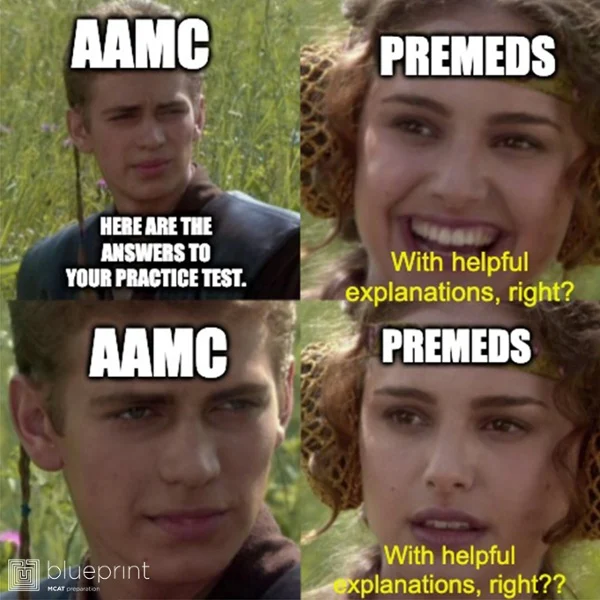
Practice exams. They are one of the most intimidating, yet important, parts of MCAT prep. From showing where you need to improve to building test-taking stamina to checking in on your progress, practice exams only become more essential as time goes on.
During MCAT study periods, all premed students should take the six available Association of American Medical Colleges (AAMC) practice exams.
However, to achieve the highest MCAT score possible, most students will take additional exams produced by people other than the AAMC for a recommended total of eight to 10 exams. This begs the question: which “third-party” practice exams are the best? In this post, we dive into why practice tests are so essential and how to choose the best exams to take for your MCAT self-prep.
Why is taking practice exams important?
Studying for the MCAT is like a marathon. Marathon training requires consistent and dedicated work on a day-to-day basis. Some days, you’ll run only a few miles or even take a day off. On other days, you might choose to do a longer run to build your stamina. As you approach race day, your long runs will get longer and more frequent while still taking care not to overextend your body or get injured. Studying for the MCAT works the same way! Over time, you’ll do more and more practice questions until MCAT test day, with some days dedicated to rest and other days dedicated to long work sessions. Taking practice exams is one of the essential parts of your MCAT prep course because it takes time and dedication to develop the capacity to sit and focus on such a long exam.
Beyond building the mental capacity to focus throughout your MCAT exam, practice tests are indispensable tools to check on your progress and assess your weaknesses. When your MCAT diagnostic test day is a month or less away, your practice scores will be what informs you as to whether you are ready to take your MCAT exam and crush your goals or if it is time to push back your MCAT date. In addition, through reviewing your practice exams, you can identify key weaknesses that you can work on to boost your score in your actual exam (but more on this later!).
What should a good practice test include?
All practice exams include the basic components of the MCAT: the four main sections—Biological and Biochemical Foundations of Living Systems; Chemical and Physical Foundations of Biological Systems; Psychological, Social, and Biological Foundations of Behavior; and Critical Analysis and Reasoning Skills—and 230 total questions. The MCAT practice exam interface should mimic exactly what you will see on your official AAMC MCAT because test-like practice is critical for preparing yourself as thoroughly as possible for test day. This is something you will not only see on all Blueprint practice tests but also on all practice questions from our AI-powered question bank!
The MCAT practice test should also work to mimic the style of the questions presented by the AAMC. While it is impossible for any company other than the AAMC to perfectly construct an MCAT practice exam, the best MCAT practice tests work as hard as possible to accurately represent the materials produced by the AAMC. At Blueprint, we have an entire team dedicated to making the highest quality, most accurate materials possible!
Why are analytics essential in tracking your progress?
Simply put, understanding what mistakes you made on one MCAT practice test is the first step to learning how to avoid making those mistakes on your next actual exam. This is why testing analytics is absolutely essential.
Testing analytics are automatically generated graphs, statistics, and other information that are 100% specific to you and your exams! Analytics for practice exams at Blueprint give you many pieces of information, including:
- 1. Your latest score trends. Your analytics page will always have an up-to-date graph of how your performance on exams and practice questions have changed over time.
- 2. Which AAMC skills are you struggling with the most? For example, you might most often miss Reasoning Beyond the Text (Skill 3) questions on CARS. Your analytics will tell you this!
- 3. Which subjects are you struggling with the most? Your analytics will show you a detailed breakdown of how many questions you get right on various topics, from general categories such as General Chemistry to more specific topics such as Optics.
- 4. Whether you second guess yourself too often. There is a graph in your analytics that will show if you have a tendency to change your answers from right to wrong! This indicates that second-guessing yourself might be a problem for you, and it illustrates how quality analytics will help you find trends you may never have noticed on your own.
Analytics are extremely useful in identifying macro-level trends, but when reviewing your exam, it is also important that you identify why you got certain questions wrong and how you can improve your performance on other similar questions in the future. This review process is part of what we at Blueprint Prep call an “LLJ,” or “Lessons Learned Journal.” It’s a spreadsheet you’ll use to help identify patterns in your mistakes and ways to improve moving forward. However, before you can make your LLJ, you first need to thoroughly understand your mistakes.
Detailed question explanations
It’s vital that your practice test offers detailed explanations for every single question and passage on your exam. There should not only be thorough explanations for why the correct answer is correct but also why every wrong answer is wrong. This is a key distinction between expert test takers and students who fall behind: the strongest test takers understand every aspect of their exam, including being able to answer questions such as “What wrong answer archetype did option A on this question fall into?” Trying to do this on your own is very difficult, which is why your practice exams should have these explanations for you to reference!
At Blueprint, we offer comprehensive explanations not only for all questions but for all passages. This includes items such as suggested highlights for individual sections, a resource that will help you learn how to identify and pull out the most high-yield information from your passages.
Conclusion
Most practice tests on the market will do their best to replicate the AAMC exams. In this way, determining which practice tests are the best actually requires you to go beyond the exam itself. Detailed analytics and high-quality answer explanations will save you time reviewing and studying and help you improve your understanding of the MCAT. Building this understanding of how the test works and what kinds of questions it asks is the key to unlocking your full MCAT potential. Learn more about Blueprint MCAT practice exams.
Want to start for free? Get our free MCAT resources, including a free practice test with analytics into your strengths and weaknesses!
Search the Blog

Free Consultation
Interested in our Online MCAT Course, One-on-One MCAT Tutoring or Med admissions packages? Set up a free consultation with one of our experienced Senior Student Advisors.
Schedule NowPopular Posts
-
MCAT Blog What's on the MCAT?
-
MCAT Blog How to Review MCAT Full Lengths

Free MCAT Practice Account
Need great MCAT practice?Get the most representative MCAT practice possible when you sign up for our free MCAT Account, which includes a half-length diagnostic exam and one of our full-length MCAT practice exams.
Learn More







